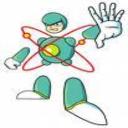A boy in a wheelchair (total mass 50.5 kg) has a speed of 1.40 m/s at the crest of a slope 2.40 m high and 12.4 m long. At the bottom of the slope, his speed is 6.50 m/s. Assume air resistance and rolling resistance can be modeled as a constant friction force of 41.0 N. Find the work he did in pushing forward on his wheels during the downhill ride.
2 Answers
Relevance
-
electron1
Lv 7
4 years ago
There are two forces that cause the wheelchair to accelerate. These two forces are the component of the wheelchair’s weight that is parallel to the hill and the force the boy exerts. The net force on the wheelchair is equal to the sum of these two forces minus the friction force. Let’s use the following equation to determine the acceleration.
vf2 = vi^2 + 2 * a * d
6.5^2 = 1.4^2 + 2 * a * 12.4
24.8 * a = 40.29
a = 40.29 ÷ 24.8
This is approximately 1.62 m/s^2.
Net force = 50.5 * 40.29 ÷ 24.8 = 2034.645 ÷ 24.8
This is approximately 82 N.
Force parallel = 50.5 * 9.8 * 2.40 ÷ 12.4 = 1187.76 ÷ 12.4
This is approximately 95.8 N. This force and the force that the boy exerts are the forces that cause the wheelchair to accelerate.
Net force = F + (1187.76 ÷ 12.4) – 41
Set the two net forces equal to each other.
F + (1187.76 ÷ 12.4) – 41 = 2034.645 ÷ 24.8
F = 41 + (2034.645 ÷ 24.8) – (1187.76 ÷ 12.4)
F is approximately 27.3 N
Work = [41 + (2034.645 ÷ 24.8) – (1187.76 ÷ 12.4)] * 12.4 = 337.9625 J
-
JupiterSky
Lv 6
4 years ago
His change in kinetic energy is due to gravitational- and his own work,
while the friction does negative work.
∆K = ∆U +∆W + ∆Wf
½m(Vf²−Vi²) = mgh + ∆W + Ff*d
∆W = ½m(Vf²−Vi²) − mgh − Ff*d
∆W = ½*50.5(6.5²−1.4²) − (50.5*9.8*2.4) − (−41*12.4)
∆W = 508 J
Still have questions? Get your answers by asking now.
Next Question
asked in Science & MathematicsPhysics · 8 years ago
What is the spring constant? please help me!!!!?
A block of mass 487 g is pushed against the
spring (located on the left-hand side of the
track) and compresses the spring a distance
4.7 cm from its equilibrium position (as shown
in the figure below). The block starts from
rest, is accelerated by the compressed spring,
and slides across a frictionless horizontal track
(as shown in the figure below). It leaves the
track horizontally, flies through the air, and
subsequently strikes the ground.
acceleration = 9.81
A) What is the spring constant?
B)What is the speed v of the block when it leaves
the track?
C) What is the total speed of the block when it
hits the ground?
...Show more
Update:
Height Above ground = 1.9 m
Lands = 4.59m away
What is the spring constant? please help me!!!!?
3 Answers
Relevance
-
Jánošík
Lv 7
8 years ago
Favorite Answer
I'm sure there is some crucial information in "the figure below" !!!
Edit:
OK... now we got something to work with ... ;-)
Time needed to fall a vertical distance of 1.9 m is:
t = √( 2h / g )
t = √[ 2×(1.9 m) / (9.81 m/s²) ]
t = 0.6224 s
In that time, the block must travel a horizontal distance of 4.59 m, so the horizontal velocity is:
r = v×t
(4.59 m) = v×(0.6224 s)
v = 7.37 m/s < - - - - - - - - - - - - - - - - - answer B
That is also the speed of the block as it leaves the spring.
Its kinetic energy at that time is:
KE = m×v²/2
KE = (0.487 kg)×(7.3749 m/s)²/2
KE = 13.244 J
That is also the elastic potential energy stored in the spring at maximum compression. So the spring constant is:
KE = PEe = k×d²/2
(13.244 J) = k×(0.047 m)²/2
k = 12 N/m < - - - - - - - - - - - - - - - - - - answer A
The gravitational potential energy of the block on the table is:
PEg = m×g×h
PEg = (0.487 kg)×(9.81 m/s²)×(1.9)
PEg = 9.077 J
The total energy of the block on the table is:
TE = PEg + PEe
TE = (9.077 J) + (13.244 J)
TE = 22.32 J
When hitting the ground, all that energy is converted to kinetic energy, so
TE = KE = m×v²/2
(22.32 J) = (0.487 kg)×v²/2
v = 9.57 m/s < - - - - - - - - - - - - - - - - - - answer C
...Show more
-
Technobuff
Lv 7
8 years ago
There must be a height above ground and a distance from the end of the track on the "as shown in the figure below".??
-
STALKER
Lv 4
8 years ago
use f=kl
where k is the spring constant and l is extension from the natural length.
k=f/l
since you have mass in grams. use w=mg
w=0.487 x 9.8 = 4.77N
Now use the equation,
k=4.77/4.7
k=1.012
Note: my answer could be wrong since I do not know the springs original length from the diagram shown. But, the method of working out spring constant is same.
...Show more
Still have questions? Get your answers by asking now.
Next Question
ひいらぎ
Lv 5
asked in Science & MathematicsPhysics · 1 decade ago
Physics Momentum, Rolling?
Pat builds a track for his model car out of wood. The track is 10.00 cm wide and 3.00 m long, and is solid. The runway is cut such that it forms a parabola by the equation y=(x - 3)^2/9. Locate the horizontal position of the center of gravity of this track.
A washing machine load in the "spin" cycle, (much like a centrifuge used to separate fluids), can be modeled as a cylinder which has zero density toward the center, and starting from some inner radius where the clothes (or fluids) begin, increases in density as you move radially outward. The washing machine has density of clothes (in SI units) of p=14r+5, a height of 0.51 m, and only has clothes present from inner radius 0.2m out to 0.7m from the center.
-What is the moment of Inertia of the wash load?
-What is the power of motor that drives the clothes from rest up to 4 rev/sec, in 14 seconds if the basin has moment of Inertia of 4 kg*.m2
...Show more
Physics Momentum, Rolling?
1 Answer
Relevance
-
Anonymous
1 decade ago
Favorite Answer
I can't visualize the first problem.
The second: Moment of inertia is I = m r^2. In a shell of thickness dr there is a mass of p * 2 * pi * r * h * dr. The moment of inertia of the shell is 2 pi h p r^3 dr. Now integrate this from r = 0.2m to r = 0.7m.
Kinetic energy is 1/2 m v^2. In rotations the moment of inertia is like the mass and the angular velocity is like the velocity, so rotational energy is 1/2 I omega^2. Omega is in rad/s. The total inertia of the system is the sum of the inertia of the clothes and the basin. Divide the energy by the time needed to get the power.
...Show more
Still have questions? Get your answers by asking now.
Next Question
asked in Science & MathematicsPhysics · 1 decade ago
Physics:You and your friends push a 75-kg...Help!?
You and your friends push a 75-kg greased pig up an aluminum slide at the county fair, starting from the low end of the slide. The coefficient of kinetic friction between the pig and the slide is 0.070.
(a) All of you pushing together (parallel to the incline) manage to accelerate the pig from rest at the constant rate of 4.9 m/s2 over a distance of 1.8 m, at which point you release the pig. The pig continues up the slide, reaching a maximum vertical height above its release point of 50 cm. What is the angle of inclination of the slide? __degree
(b) At the maximum height the pig turns around and begins to slip down the slide, how fast is it moving when it arrives at the low end of the slide? __m/s
...Show more
Physics:You and your friends push a 75-kg...Help!?
1 Answer
Relevance
-
Anonymous
1 decade ago
Favorite Answer
♣the distance the pig was pushed up is
s=0.5*a*t^2, where s=1.8m, a=4.9m/s^2, t is time of push-up;
speed of the pig gained after s=1.8m is v=a*t; thus v^2=2as;
♠ kinetic energy of the pig at the moment it’s released after push-up is
E=0.5*m*v^2, which is enough for the pig to move by itself L distance more along the ramp, where L=h/sin(b), h=50cm=0.5m, b is angle in question;
♦pig’s potential energy at vertex (when stopped) is E1=mgh;
the energy E2=E-E1 is gone on friction, that is E2=f*L is work of friction, where
f=μ*w1, w1=mg*cos(b) is component of pig’s weight normal to the aluminum ramp; or;
f= μ*mg*cos(b);
♦Thus E2=E-E1; or; f*L = 0.5*m*v^2 –mgh; or;
(μ*mg*cos(b)) * (h/sin(b)) =0.5*m* 2as –mgh; or;
μ*gh*cos(b)/sin(b) =as –gh, hence cot(b) =(as –gh)/(μ*gh), hence
(a); b=atan(μ*gh/(as-gh))= atan(0.07*9.8*0.5/(4.9*1.8 -9.8*0.5)) =5°;
♥ pig’s potential energy above the low end of the ramp is
W= mg*(s*sin(b) +h); pig’s ramp position is p=s +L = s + h/sin(b);
Pig’s final kinetic energy is W1=W-W2, where W2=f*p is work of friction;
and W1=0.5*m*v^2; thus
0.5*m*v^2 = mg*(s*sin(b) +h) – μ*mg*cos(b)*(s + h/sin(b));
v^2 =2g*(s*sin(b) +h)*(1 –μ*cot(b)) =2.575;
(b); v =1.605 m/s;
...Show more
Still have questions? Get your answers by asking now.
A boy in a wheelchair (total mass 50.5 kg) has a speed of 1.40 m/s at the crest of a slope 2.40 m high and 12.4 m long. At the bottom of the slope, his speed is 6.50 m/s. Assume air resistance and rolling resistance can be modeled as a constant friction force of 41.0 N. Find the work he did in pushing forward on his wheels during the downhill ride.
2 Answers
-
electron1Lv 74 years ago
There are two forces that cause the wheelchair to accelerate. These two forces are the component of the wheelchair’s weight that is parallel to the hill and the force the boy exerts. The net force on the wheelchair is equal to the sum of these two forces minus the friction force. Let’s use the following equation to determine the acceleration.
vf2 = vi^2 + 2 * a * d
6.5^2 = 1.4^2 + 2 * a * 12.4
24.8 * a = 40.29
a = 40.29 ÷ 24.8
This is approximately 1.62 m/s^2.
Net force = 50.5 * 40.29 ÷ 24.8 = 2034.645 ÷ 24.8
This is approximately 82 N.
Force parallel = 50.5 * 9.8 * 2.40 ÷ 12.4 = 1187.76 ÷ 12.4
This is approximately 95.8 N. This force and the force that the boy exerts are the forces that cause the wheelchair to accelerate.
Net force = F + (1187.76 ÷ 12.4) – 41
Set the two net forces equal to each other.
F + (1187.76 ÷ 12.4) – 41 = 2034.645 ÷ 24.8
F = 41 + (2034.645 ÷ 24.8) – (1187.76 ÷ 12.4)
F is approximately 27.3 N
Work = [41 + (2034.645 ÷ 24.8) – (1187.76 ÷ 12.4)] * 12.4 = 337.9625 J
-
JupiterSkyLv 64 years ago
His change in kinetic energy is due to gravitational- and his own work,
while the friction does negative work.
∆K = ∆U +∆W + ∆Wf
½m(Vf²−Vi²) = mgh + ∆W + Ff*d
∆W = ½m(Vf²−Vi²) − mgh − Ff*d
∆W = ½*50.5(6.5²−1.4²) − (50.5*9.8*2.4) − (−41*12.4)
∆W = 508 J
What is the spring constant? please help me!!!!?
A block of mass 487 g is pushed against the
spring (located on the left-hand side of the
track) and compresses the spring a distance
4.7 cm from its equilibrium position (as shown
in the figure below). The block starts from
rest, is accelerated by the compressed spring,
and slides across a frictionless horizontal track
(as shown in the figure below). It leaves the
track horizontally, flies through the air, and
subsequently strikes the ground.
acceleration = 9.81
A) What is the spring constant?
B)What is the speed v of the block when it leaves
the track?
C) What is the total speed of the block when it
hits the ground?
Height Above ground = 1.9 m
Lands = 4.59m away
3 Answers
-
JánošíkLv 78 years agoFavorite Answer
I'm sure there is some crucial information in "the figure below" !!!
Edit:
OK... now we got something to work with ... ;-)
Time needed to fall a vertical distance of 1.9 m is:
t = √( 2h / g )
t = √[ 2×(1.9 m) / (9.81 m/s²) ]
t = 0.6224 s
In that time, the block must travel a horizontal distance of 4.59 m, so the horizontal velocity is:
r = v×t
(4.59 m) = v×(0.6224 s)
v = 7.37 m/s < - - - - - - - - - - - - - - - - - answer B
That is also the speed of the block as it leaves the spring.
Its kinetic energy at that time is:
KE = m×v²/2
KE = (0.487 kg)×(7.3749 m/s)²/2
KE = 13.244 J
That is also the elastic potential energy stored in the spring at maximum compression. So the spring constant is:
KE = PEe = k×d²/2
(13.244 J) = k×(0.047 m)²/2
k = 12 N/m < - - - - - - - - - - - - - - - - - - answer A
The gravitational potential energy of the block on the table is:
PEg = m×g×h
PEg = (0.487 kg)×(9.81 m/s²)×(1.9)
PEg = 9.077 J
The total energy of the block on the table is:
TE = PEg + PEe
TE = (9.077 J) + (13.244 J)
TE = 22.32 J
When hitting the ground, all that energy is converted to kinetic energy, so
TE = KE = m×v²/2
(22.32 J) = (0.487 kg)×v²/2
v = 9.57 m/s < - - - - - - - - - - - - - - - - - - answer C
...Show more -
TechnobuffLv 78 years ago
There must be a height above ground and a distance from the end of the track on the "as shown in the figure below".??
-
STALKERLv 48 years ago
use f=kl
where k is the spring constant and l is extension from the natural length.
k=f/l
since you have mass in grams. use w=mg
w=0.487 x 9.8 = 4.77N
Now use the equation,
k=4.77/4.7
k=1.012
Note: my answer could be wrong since I do not know the springs original length from the diagram shown. But, the method of working out spring constant is same.
...Show more
Physics Momentum, Rolling?
Pat builds a track for his model car out of wood. The track is 10.00 cm wide and 3.00 m long, and is solid. The runway is cut such that it forms a parabola by the equation y=(x - 3)^2/9. Locate the horizontal position of the center of gravity of this track.
A washing machine load in the "spin" cycle, (much like a centrifuge used to separate fluids), can be modeled as a cylinder which has zero density toward the center, and starting from some inner radius where the clothes (or fluids) begin, increases in density as you move radially outward. The washing machine has density of clothes (in SI units) of p=14r+5, a height of 0.51 m, and only has clothes present from inner radius 0.2m out to 0.7m from the center.
-What is the moment of Inertia of the wash load?
-What is the power of motor that drives the clothes from rest up to 4 rev/sec, in 14 seconds if the basin has moment of Inertia of 4 kg*.m2
1 Answer
-
Anonymous1 decade agoFavorite Answer
I can't visualize the first problem.
The second: Moment of inertia is I = m r^2. In a shell of thickness dr there is a mass of p * 2 * pi * r * h * dr. The moment of inertia of the shell is 2 pi h p r^3 dr. Now integrate this from r = 0.2m to r = 0.7m.
Kinetic energy is 1/2 m v^2. In rotations the moment of inertia is like the mass and the angular velocity is like the velocity, so rotational energy is 1/2 I omega^2. Omega is in rad/s. The total inertia of the system is the sum of the inertia of the clothes and the basin. Divide the energy by the time needed to get the power.
...Show more
Physics:You and your friends push a 75-kg...Help!?
You and your friends push a 75-kg greased pig up an aluminum slide at the county fair, starting from the low end of the slide. The coefficient of kinetic friction between the pig and the slide is 0.070.
(a) All of you pushing together (parallel to the incline) manage to accelerate the pig from rest at the constant rate of 4.9 m/s2 over a distance of 1.8 m, at which point you release the pig. The pig continues up the slide, reaching a maximum vertical height above its release point of 50 cm. What is the angle of inclination of the slide? __degree
(b) At the maximum height the pig turns around and begins to slip down the slide, how fast is it moving when it arrives at the low end of the slide? __m/s
1 Answer
-
Anonymous1 decade agoFavorite Answer
♣the distance the pig was pushed up is
s=0.5*a*t^2, where s=1.8m, a=4.9m/s^2, t is time of push-up;
speed of the pig gained after s=1.8m is v=a*t; thus v^2=2as;
♠ kinetic energy of the pig at the moment it’s released after push-up is
E=0.5*m*v^2, which is enough for the pig to move by itself L distance more along the ramp, where L=h/sin(b), h=50cm=0.5m, b is angle in question;
♦pig’s potential energy at vertex (when stopped) is E1=mgh;
the energy E2=E-E1 is gone on friction, that is E2=f*L is work of friction, where
f=μ*w1, w1=mg*cos(b) is component of pig’s weight normal to the aluminum ramp; or;
f= μ*mg*cos(b);
♦Thus E2=E-E1; or; f*L = 0.5*m*v^2 –mgh; or;
(μ*mg*cos(b)) * (h/sin(b)) =0.5*m* 2as –mgh; or;
μ*gh*cos(b)/sin(b) =as –gh, hence cot(b) =(as –gh)/(μ*gh), hence
(a); b=atan(μ*gh/(as-gh))= atan(0.07*9.8*0.5/(4.9*1.8 -9.8*0.5)) =5°;
♥ pig’s potential energy above the low end of the ramp is
W= mg*(s*sin(b) +h); pig’s ramp position is p=s +L = s + h/sin(b);
Pig’s final kinetic energy is W1=W-W2, where W2=f*p is work of friction;
and W1=0.5*m*v^2; thus
0.5*m*v^2 = mg*(s*sin(b) +h) – μ*mg*cos(b)*(s + h/sin(b));
v^2 =2g*(s*sin(b) +h)*(1 –μ*cot(b)) =2.575;
(b); v =1.605 m/s;
...Show more
For unlimited access to Homework Help, a Homework+ subscription is required.





